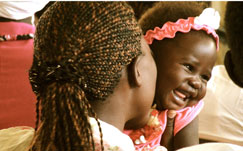South Africa tots up population wins
24 July 2015
Just over a week ago, on 14 July, UNAids released its report,
How Aids Has
Changed Everything – Meeting the MDG Targets.
It said the world had met and exceeded the Aids targets of Millennium Development
Goal Six, and was on track to end the Aids epidemic by 2030 as part of the
Sustainable Development Goals. Among other nations, it spoke of South Africa as
one of the countries that had made significant strides in halting and reversing the
epidemic.
Yesterday, Statistics South Africa added its research to the story. About one in 10
South Africans was living with HIV, it said in its mid-year population estimates
report, published on 23 July.
Speaking at its release in Pretoria, statistician-general Pali Lehohla said 6.19 million
South Africans were living with the disease, out of an estimated total population of
54.95 million people, or 11.2%.
The number of South Africans infected with HIV had
increased by 2.17 million since
2002, when 4.02 million South Africans were HIV-positive. However, he said,
infections were declining, with the incidence rate among people between the ages of
15 and 49 waning.
A reduction of infections in people aged between 15 and 24 bore this out: in 2002,
6.75% of this group was infected with HIV, dropping to 5.59% in 2015.
In addition, there had been a gradual drop in Aids-related deaths since 2002. In its
mid-year report, Stats SA estimated that 531 965 people had died, with 162 445 of
those being Aids-related, or 30.5%. In 2002, 44.6% of all deaths were Aids-related;
this figure peaked in 2005 at 50.7%.
Saved by treatment
UNAids said that the goal of 15 million people on life-saving HIV treatment by 2015
had been met nine months ahead of schedule. In 2014, the report showed that 83
countries, which accounted for 83% of all people living with HIV, had halted or
reversed their epidemics,
including countries with major epidemics, such as South
Africa, India, Kenya, Mozambique and Zimbabwe.
"Countries that rapidly mounted robust responses to their epidemics saw impressive
results. South Africa turned around its decline in life expectancy within 10 years,
rising from 51 years in 2005 to 61 by the end of 2014, on the back of a massive
increase in access to antiretroviral therapy," UNAids said.
"South Africa has the largest HIV treatment programme in the world, with more
than 3.1 million people on antiretroviral therapy, funded almost entirely from
domestic sources. In the last five years alone, AIDS-related deaths have declined
by 58% in South Africa."
Life expectancy lengthens
Stats SA also looked at life expectancy. "We need to look at what progress is being
achieved in demographics," Lehohla said. "Life expectancy is increasing. That is the
biggest demographic gain the world observes."
In Africa, life expectancy
had increased by 20 years since the 1950s. In South
Africa, average life expectancy in 2015 was 62.5 years, up 9.1 years since 2004.
The average life expectancy for a South African male was 60.6 years, for a female
it was 64.2 years.
The increase in average life expectancy was matched by a drop in both the infant
mortality rate and the children-under-five mortality rate. In 2002, the infant
mortality rate was 51.2 babies per 1 000 live births; it peaked at 52 babies per 1
000 live births. In 2015, this number had dropped to 34.4 deaths per 1 000 live
births.
Similarly, in 2002, there were 77.2 deaths per 1 000 children among those under
five, peaking at 79.1 in 2005. In 2015, this figure has dropped significantly to 45.1
deaths per 1 000 children.
Meanwhile, Lehohla said, on average, South African women were having 2.55
children each since 2011, a drop from 2.79 in 2002. While Gauteng had the lowest
birth rate in South Africa, it was the
country's most populated province, with 13.2
million people – 24% of the country's total population.
Turning to population, Stats SA said the country’s population had grown 1.65% from
2014 to 2015, compared with 1.28% from 2002 to 2003. The natural rate of the
increase was 1.3% in 2015, with the remainder being made up by migration.
SAinfo reporter
 Mother and child. (Image: Pixabay)
Mother and child. (Image: Pixabay)




